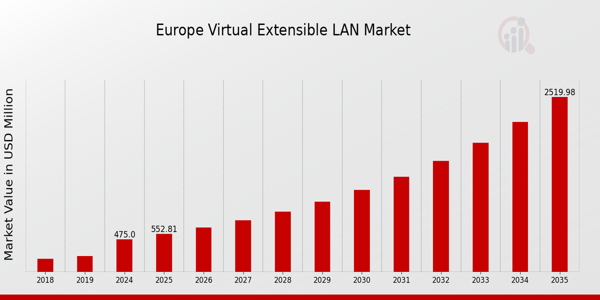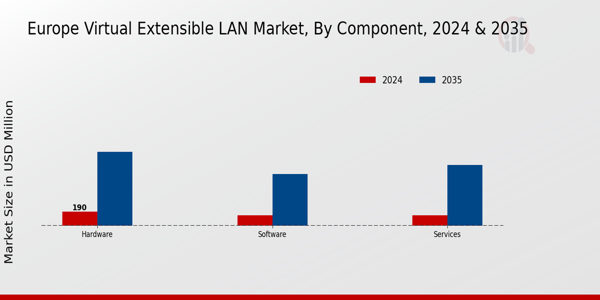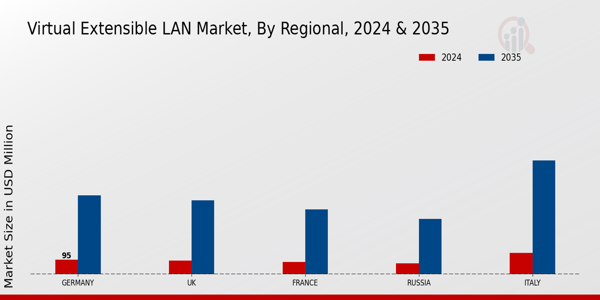Europe Virtual Extensible LAN Market Overview
As per MRFR analysis, the Europe Virtual Extensible LAN Market Size was estimated at 409.48 (USD Million) in 2023. The Europe Virtual Extensible LAN Market is expected to grow from 475(USD Million) in 2024 to 2519.98 (USD Million) by 2035. The Europe Virtual Extensible LAN Market CAGR (growth rate) is expected to be around 16.381% during the forecast period (2025 - 2035).
Key Europe Virtual Extensible LAN Market Trends Highlighted
The demand for scalable and flexible networking solutions is the primary factor driving the significant growth of the Europe Virtual Extensible LAN market. The proliferation of cloud computing and big data analytics has prompted organizations to adopt Virtual Extensible LAN technologies as they endeavor to enhance network performance and manage data more efficiently.
Additionally, the significant market driver that motivates companies to improve their IT infrastructure is the push toward digital transformation across a variety of industries in Europe. Governments in the region are also advocating for the adoption of cloud technology and the enhancement of digital infrastructure, which has resulted in a more favorable environment for the deployment of Virtual Extensible LANs.
Additionally, there are numerous prospects for market expansion, particularly in industries like finance, healthcare, and education, where secure and dependable connectivity is necessary. Robust network solutions that can accommodate the disparate needs of employees working from various locations are now necessary due to the increasing prevalence of remote work and hybrid working models. This transition to a more adaptable work environment presents new opportunities for the adoption of Virtual Extensible LANs in Europe. In recent years, there has been a growing recognition of the significance of cybersecurity among organizations, resulting in a greater emphasis on secure networking solutions.
Consequently, organizations are migrating to Virtual Extensible LANs, which can provide more effective protection for sensitive data by providing isolated environments. Furthermore, the capabilities of Virtual Extensible LANs are expected to be further enhanced by technological advancements, including automation and artificial intelligence, which will render them more appealing to businesses throughout the continent. In general, the future landscape of the Virtual Extensible LAN market in Europe is being influenced by the convergence of digital transformation, flexible work policies, and enhanced security measures.

Source: Primary Research, Secondary Research, Market Research Future Database, and Analyst Review
Europe Virtual Extensible LAN Market Drivers
Growing Demand for Efficient Network Solutions
The increasing need for efficient and scalable networking solutions is a significant driver for the Europe Virtual Extensible LAN Market Industry. With the rise in virtual networks and the demand for data center extensibility, organizations are increasingly adopting Virtual Extensible LAN (VXLAN) technology to overcome the limitations of traditional Local Area Networks (LANs). For example, recent reports from the European Commission highlight that 62% of European businesses are investing in digital transformation initiatives, which include enhancing their networking capabilities to support remote work and cloud computing demands.
This shift in operational practices has led to a recognition of the effectiveness of VXLAN in providing flexibility and scalability, thereby fueling the market growth in Europe. Furthermore, major telecommunications companies in Europe, such as Deutsche Telekom and BT Group, are actively integrating VXLAN solutions to improve service delivery and customer satisfaction. Their initiatives are indicative of a broader trend where organizations are looking to adopt advanced networking solutions, driving further growth in the Europe Virtual Extensible LAN Market.
Increased Adoption of Cloud Services
The accelerated adoption of cloud services across Europe is another key factor propelling the Europe Virtual Extensible LAN Market Industry. According to the European Cloud Initiative, cloud adoption among European enterprises has reached approximately 74% in recent years. As businesses migrate their data and applications to the cloud, the need for seamless communication between various environments becomes crucial, leading to the popularity of VXLAN for network virtualization.
Notable examples include cloud service providers like Amazon Web Services and Microsoft Azure, which have successfully implemented VXLAN to enhance their networking infrastructure, thus paving the way for more businesses to follow suit. This trend not only enhances performance through efficient network segmentation but also increases the demand for Virtual Extensible LAN technologies within Europe.
Emphasis on Security and Compliance
As cybersecurity threats continue to rise across Europe, there is an increased focus on implementing secure network architectures. The Europe Virtual Extensible LAN Market Industry benefits from this trend, as VXLAN allows for better isolation and segmentation of network traffic, which is vital for compliance with regulations such as the General Data Protection Regulation (GDPR).
According to an analysis by the European Union Agency for Cybersecurity, phishing attacks in Europe grew by 44% in the past year, highlighting the need for robust and agile security measures.Organizations across the continent are prioritizing the deployment of network solutions that can facilitate compliance and enhance security, with the adoption of VXLAN being a crucial part of this strategy. Hence, the growing demand for secure networking solutions significantly bolsters the Europe Virtual Extensible LAN Market.
Rapid Technological Advancements
Technological advancements in networking and virtualization technology are a major driver of growth in the Europe Virtual Extensible LAN Market Industry. Innovations such as software-defined networking and network function virtualization are transforming how networks operate, and VXLAN stands out as a critical enabler of these technologies.
The European Telecommunications Standards Institute (ETSI) has been actively working on standardizing these technologies, which streamlines their adoption across various sectors.As a result, the European industry is witnessing an increase in investment in network infrastructure, with projections indicating a 20% growth in budget allocations for digital infrastructure, including virtualization solutions. This investment trend reflects a strong commitment from organizations to advance their networking capabilities, which directly benefits the VXLAN market in Europe.
Europe Virtual Extensible LAN Market Segment Insights
Virtual Extensible LAN Market Component Insights
The Europe Virtual Extensible LAN Market, particularly in the Component segment, is growing in significance due to the increasing demand for scalable and efficient networking solutions. This growth can be attributed to the ongoing digital transformation across various industries in Europe, as organizations increasingly seek to enhance their IT infrastructure. In this landscape, the importance of hardware components cannot be understated, as they play a crucial role in supporting the networking framework necessary for virtual extensible LAN implementations. Efficient hardware solutions facilitate high-capacity data transmission, improve connectivity, and offer enhanced management features, proving essential for businesses aiming to streamline their operations.
On the other hand, software components serve as the backbone of network control and management, enabling seamless communication and optimization of resources in virtualized environments. Software solutions equipped with advanced analytics and security features are in demand as organizations prioritize data integrity and network performance. Furthermore, the growing reliance on cloud technologies and the adoption of a remote work culture have amplified the necessity for robust software tools that enable the setup and management of virtual networks over expansive geographical areas.
Moreover, the Services aspect of the Component segment addresses the need for expertise in designing, implementing, and maintaining virtual extensible LAN solutions. This includes professional services like consulting, technical support, and training, which help organizations navigate the complexities of deploying such technologies. As organizations in Europe invest in upgrading their network capabilities, the Services segment is poised to grow significantly, offering essential support to ensure optimal performance and user satisfaction.
The trends within the Europe Virtual Extensible LAN Market reflect a clear shift toward integrated solutions that incorporate hardware, software, and services, all working together to facilitate efficient and scalable network architectures. This integration not only enhances overall network performance but also underscores the importance of each component in achieving a cohesive and resilient infrastructure, ready to meet the demands of a rapidly evolving digital landscape. As Europe continues to strengthen its position as a leader in technology and innovation, the synergies among these components will be pivotal in driving market growth. Organizations are increasingly recognizing the value these components add to their overall digital strategy, making the Component segment a critical focus area in the Europe Virtual Extensible LAN Market.

Source: Primary Research, Secondary Research, Market Research Future Database, and Analyst Review
Virtual Extensible LAN Market Enterprise Size Insights
The Europe Virtual Extensible LAN Market, categorized by Enterprise Size, reveals a diverse landscape where both Large Enterprises and Small and Medium Enterprises (SMEs) play critical roles. Large Enterprises often lead in adopting advanced networking solutions due to their complex infrastructures and need for robust scalability, which positions them strategically in the market. Their significant resources allow them to implement innovative technologies, thereby enhancing operational efficiencies.
On the other hand, SMEs, while smaller in scale, are increasingly recognizing the importance of Virtual Extensible LAN technologies to improve connectivity and reduce operational costs.As digitization accelerates across Europe, SMEs are becoming more agile, leveraging Virtual Extensible LAN solutions to streamline their networking capabilities. The disparity in adoption levels highlights a growing opportunity for vendors to address the unique needs of each segment, fostering targeted product development.
Market trends indicate that collaboration among large organizations and SMEs can create synergistic benefits, driving the overall growth of the Virtual Extensible LAN market in Europe. With the European government's push for digital transformation, both segments are expected to see expanded opportunities, underscoring the importance of tailored offerings to meet distinct market demands.
Virtual Extensible LAN Market Application Insights
The Application segment of the Europe Virtual Extensible LAN Market plays a critical role in shaping network infrastructure and cloud services across the region. Multi-tenancy is gaining traction as organizations seek to optimize resource usage and cost efficiency by allowing multiple clients to share the same physical resources securely and efficiently. Workload mobility is integral in today’s fast-paced business environment, enabling seamless movement of applications and workloads across various environments, thereby enhancing operational flexibility.Software-Defined Networking (SDN) overlays facilitate better network control and agility, essential for adapting to changing business needs and improving the overall user experience.
Furthermore, Network Function Virtualization (NFV) emerges as a significant component, offering the potential to reduce hardware dependencies and improve service delivery. Disaster recovery solutions are increasingly vital for business continuity, underscoring the importance of robust backup and failover systems in a digital-first landscape. Together, these elements reflect a dynamic and evolving market landscape that is pivotal for businesses operating across Europe, driving the demand for innovative networking solutions.Significant investment in cybersecurity and regulatory compliance also magnifies the importance of these applications as organizations strive to safeguard data while enhancing network capabilities.
Virtual Extensible LAN Market End-User Industry Insights
The Europe Virtual Extensible LAN Market is poised for robust growth driven by demand across various end-user industries, including Banking, Financial Services and Insurance (BFSI), Healthcare, IT and telecommunications, Government, Retail, Manufacturing, and Media and Entertainment. Each of these sectors leverages the technology to enhance network efficiency and scalability, addressing the growing need for seamless communication and data transfer. The BFSI sector is increasingly adopting virtual networking solutions to ensure secure transactions and regulatory compliance, while healthcare organizations utilize these technologies to facilitate interoperability and streamline operations.The IT and telecommunications industry continues to dominate with the demand for efficient data center management and improved customer service capabilities.
Government agencies focus on enhancing national security and improving public services through better network infrastructure. Retailers are leveraging virtual extensible LAN solutions to manage their vast data flows and enhance customer experiences. Moreover, the Manufacturing sector uses these technologies to integrate IoT devices and improve production efficiency. The Media and Entertainment industry benefits from the ability to deliver high-quality content with minimal latency.Overall, the increasing digital transformation efforts across these verticals bolster the Europe Virtual Extensible LAN Market, presenting significant growth opportunities as businesses seek to innovate and optimize their network infrastructures.
Virtual Extensible LAN Market Regional Insights
The Europe Virtual Extensible LAN Market shows a diverse landscape across various countries, each contributing distinctively to its overall growth trajectory. Germany is known for its robust industrial base and high adoption of advanced networking technologies, which positions it as a key player in this market. The UK follows closely, leveraging its strong financial sector's demand for efficient data management solutions, thereby fostering substantial market activity. France demonstrates a growing inclination towards digital transformation initiatives, making it a vital region for further innovation in Virtual Extensible LAN technologies.
In Russia, a region rich in IT talent, the market is poised to grow due to increasing governmental support for digital infrastructure. Italy showcases significant interest in networking solutions among both enterprises and small to medium businesses, while Spain is experiencing a surge in demand driven by rising cloud adoption. The rest of Europe similarly holds potential, characterized by varying degrees of market penetration and technological adoption.
Overall, regional dynamics reflect not only the specific economic environments but also the collective push towards enhanced connectivity solutions, fostering opportunities and challenges unique to each market space.This segmentation within the Europe Virtual Extensible LAN Market illustrates a landscape ripe for investment and development, alongside the interplay of local regulations and adoption rates influencing overall growth.

Source: Primary Research, Secondary Research, Market Research Future Database, and Analyst Review
Europe Virtual Extensible LAN Market Key Players and Competitive Insights
The Europe Virtual Extensible LAN Market is characterized by a dynamic landscape where various networking solutions come together to create a more efficient and agile IT infrastructure for enterprises. As industries progressively transition towards digital transformation, the demand for high-performance networking solutions such as Virtual Extensible LAN (VXLAN) is on the rise. This technology facilitates the creation of virtual networks on top of existing physical networks, thereby enhancing scalability and optimizing data centers. The competitive landscape is marked by the presence of several leading players who are innovating and expanding their offerings to capture market share.
The increased adoption of cloud services and multimedia applications has spurred growth in this sector, with companies competing not only on technology advancements but also on customer support and overall service quality. As organizations seek to build robust and flexible environments, the initiatives taken by these key players are critical to shaping the future of the Europe Virtual Extensible LAN Market.Arista Networks has established a significant presence in the Europe Virtual Extensible LAN Market, primarily known for its high-performance cloud networking solutions. The company differentiates itself with its advanced operating system and hardware designed for data center and cloud-based environments, facilitating seamless integration of VXLAN technologies.
Arista Networks boasts strengths such as its innovative approach to network management, enabling customers to achieve optimal performance and scalability with ease. Moreover, the company’s focus on software-driven networking helps enterprises adapt swiftly to evolving market demands. Arista’s commitment to enhancing customer experience through extensive support services has also positioned it favorably within the European market. Its robust research and development framework further solidifies its reputation as a thought leader in providing scalable and efficient networking solutions that cater specifically to the needs of European businesses.
Hewlett Packard Enterprise has solidified its role as a pivotal player in the Europe Virtual Extensible LAN Market through innovative networking solutions and a strong market presence. The company offers a range of key products and services centered around virtualization and data center optimization, including its proprietary networking hardware and HPE Aruba solutions that support VXLAN architectures.
HPE's strengths lie in its ability to deliver comprehensive networking solutions that integrate seamlessly with existing IT environments, thereby empowering organizations to enhance their operational efficiency. Additionally, the company has engaged in strategic mergers and acquisitions to bolster its portfolio, ensuring that it remains competitive in the rapidly evolving market landscape. By continuously investing in research and development, HPE not only enhances its product offerings but also responds adeptly to emerging trends and customer needs across Europe. Its commitment to providing robust technology solutions, combined with excellent customer service, positions HPE as a key contender in shaping the future of networking in the region.
Key Companies in the Europe Virtual Extensible LAN Market Include:
- Arista Networks
- Hewlett-Packard Enterprise
- Cisco
- Juniper Networks
- NVIDIA
- Extreme Networks
- Huawei
- Palo Alto Networks
- Dell Technologies
- Microsoft
- IBM
- VMware
Europe Virtual Extensible LAN Market Industry Developments
In recent months, the Europe Virtual Extensible LAN Market has shown significant developments. Arista Networks and Cisco have announced collaborations focusing on enhancing software-defined networking capabilities, aiming to streamline network management across multiple data centers. Similarly, in August 2023, VMware expanded its reach in Europe through the acquisition of a security-focused company, further emphasizing the importance of cybersecurity in networking frameworks.
The market has seen considerable growth, driven by the increasing demand for scalable and efficient networking solutions, with estimates suggesting a valuation increase of over 25% over two years due to digital transformation initiatives across various industries.
Cisco's introduction of innovative VxLAN technologies in May 2023 has also had a positive impact on network scalability and flexibility. Furthermore, with increasing data transfer speeds and cloud adoption, companies like Dell Technologies and Oracle are enhancing their VxLAN offerings to cater to evolving customer needs in Europe.
Europe Virtual Extensible LAN Market Segmentation Insights
Virtual Extensible LAN Market Component Outlook
- Hardware
- Software
- Services
Virtual Extensible LAN Market Enterprise Size Outlook
Virtual Extensible LAN Market Application Outlook
- Multi-tenancy
- Workload mobility
- Software-Defined Networking (SDN) overlays
- Network Function Virtualization (NFV)
- Disaster recovery
- Others
Virtual Extensible LAN Market End-User Industry Outlook
- BFSI
- Healthcare
- IT & telecommunications
- Government
- Retail
- Manufacturing
- Media and entertainment
- Others
Virtual Extensible LAN Market Regional Outlook
- Germany
- UK
- France
- Russia
- Italy
- Spain
- Rest of Europe
| Report Attribute/Metric Source: |
Details |
| MARKET SIZE 2023 |
409.48(USD Million) |
| MARKET SIZE 2024 |
475.0(USD Million) |
| MARKET SIZE 2035 |
2520.0(USD Million) |
| COMPOUND ANNUAL GROWTH RATE (CAGR) |
16.381% (2025 - 2035) |
| REPORT COVERAGE |
Revenue Forecast, Competitive Landscape, Growth Factors, and Trends |
| BASE YEAR |
2024 |
| MARKET FORECAST PERIOD |
2025 - 2035 |
| HISTORICAL DATA |
2019 - 2024 |
| MARKET FORECAST UNITS |
USD Million |
| KEY COMPANIES PROFILED |
Arista Networks, Hewlett Packard Enterprise, Cisco, Juniper Networks, NVIDIA, Extreme Networks, Huawei, Palo Alto Networks, Dell Technologies, Lenovo, Microsoft, Oracle, Cumulus Networks, IBM, VMware |
| SEGMENTS COVERED |
Component, Enterprise Size, Application, End-User Industry, Regional |
| KEY MARKET OPPORTUNITIES |
Increased demand for cloud services, Rising adoption of IoT applications, Enhanced network scalability requirements, Growing focus on network security, Multi-tenancy in data centers |
| KEY MARKET DYNAMICS |
growing demand for scalability, increasing adoption of cloud solutions, need for enhanced network security, rising trends in virtualization, improvement in data center efficiency |
| COUNTRIES COVERED |
Germany, UK, France, Russia, Italy, Spain, Rest of Europe |
Frequently Asked Questions (FAQ):
The projected market size of the Europe Virtual Extensible LAN Market in 2024 is valued at 475.0 million USD.
By 2035, the Europe Virtual Extensible LAN Market is expected to reach a valuation of 2520.0 million USD.
The expected CAGR for the Europe Virtual Extensible LAN Market from 2025 to 2035 is 16.381%.
Germany holds the largest market share in the Europe Virtual Extensible LAN Market, valued at 95.0 million USD in 2024.
The UK market for Virtual Extensible LAN is valued at 90.0 million USD in 2024.
In 2024, the market size for Virtual Extensible LAN in France is projected to be 80.0 million USD.
Key players in the Europe Virtual Extensible LAN Market include Arista Networks, Cisco, and Hewlett Packard Enterprise among others.
The hardware component is expected to reach a market size of 1000.0 million USD by 2035.
The services segment is projected to grow to 820.0 million USD by 2035.
The Europe Virtual Extensible LAN Market faces challenges related to rapid technological advancements and cyber security threats.

















